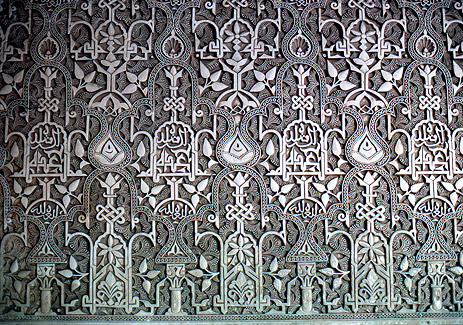Image Resource Bank
Image Gallery |  11 of 15
11 of 15 
An Abstract Art
The Alhambra palace in Granada, Spain, was built during the middle and latter parts of the 14th century CE by the Nasrids, one of the last dynasties of Muslim rulers in Spain. Many of its rooms contain splendid decoration, particularly in tilework or, as shown here, carved stucco. Although essentially a secular monument, the style of much of the art in the Alhambra reflects the fashions of Islamic religious art—in particular, its avoidance of any representation of a human or animal form. Instead, artistic decoration is based on plant motifs or purely geometrical designs; sometimes, as here, the patterns seem to combine some vegetal motifs (such as flower buds or, possibly, stylized representations of a pomegranate) with more abstract tracery. In this respect, Islamic religious art differs markedly from both Christian and Jewish art, which could be representational and often depicted scenes from their scriptures (see Images 6, 10). As a secular monument, parts of the Alhambra did contain animal figures (notably in its famous fountain of the lions), and Islamic art not intended for the mosque, such as miniature paintings, commonly depicted people and animals. But Islamic art intended for religious spaces, particularly the mosque, is non-representational and abstract.
Name: Stucco decoration (detail), Alhambra Palace, Granada, Spain.
Material: Carved stucco
Size: Unknown
Date: 14th century CE
Place of Origin: Alhambra Palace, Granada, Spain
Location: Alhambra Palace, Granada, Spain
Registration # and Source: Photograph by Fred M. Donner, July, 1985 CE.
Material: Digital photograph from 35mm slide
Size: Approx. 20 cm (7.9 in) x 30 cm (11.8 in)
Date: 1985 

Fred M. Donner
Professor of Near Eastern History, University of Chicago




